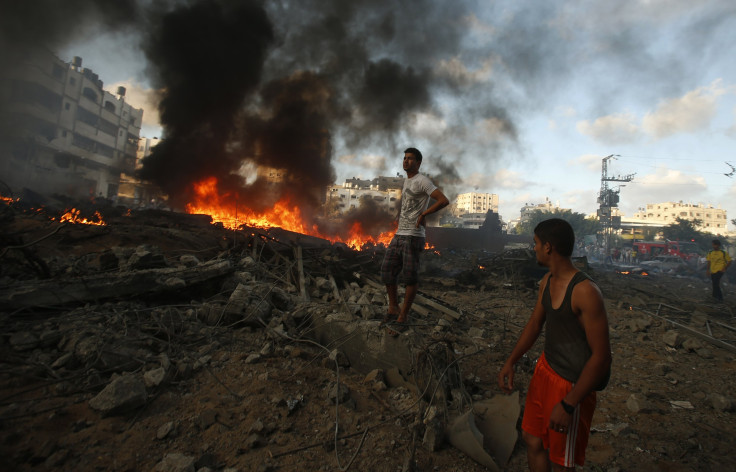Palestinian Protests Break Out In West Bank As Death Toll Rises [VIDEO]

For the first time since the start of the Israel and Gaza clashes earlier this month, the conflict has spread to the West Bank. Thousands of people marched from Ramallah to Jerusalem on Thursday night to protest Israel denying them entrance to Al-Aqsa mosque and to express their solidarity with Gaza.
When protestors reached the Qalandiyah checkpoint, a militarized checkpoint between Ramallah and Jerusalem that passes through Israel’s separation wall, reports say they were met with live ammunition and tear gas from Israeli security forces. Protesters show no sign of backing down and solidarity demonstrations are reported to have popped up in the Al Aqsa, Nablus, Jerusalem and Al-Khalil neighborhoods. Many are saying it looks like the beginning of the Third Intifada.
Palestinians' first intifada, or uprising, was from 1987 to 1993, and the second raged from 2000 to around 2005.
Qalandia today reminded me of the second Intifada. Feels like a third Intifada has started. #PalestineUnderAttack #Gaza #GazaUnderAttack
— Qatoot (@Qatoot88) July 25, 2014Getting reports from friends in West Bank that PA has called for Third Intifada, will organize buses to try to enter Jerusalem tomorrow.
— Max Blumenthal (@MaxBlumenthal) July 24, 2014So far, there are two dead and at least 200 wounded in the West Bank, but those numbers are expected to rise. Nineteen-year-old Mohammad al-Araj and 27-year-old Majd Sufyan were both killed in the protest, a Palestinian news agency Ma'an reporter at the scene said. According to Haaretz, the Ramallah Government Hospital was "filled" with wounded protesters and operating rooms and waiting areas there were at capacity. Those with light injuries have been asked to leave.
"These are scenes out of the first intifada," said Palestinians who were part of that particular uprising who came to the hospital when they heard their sons and daughters were wounded by IDF gunfire, according to Haaretz.
Palestinian youth grabs shield of fleeing IDF soldier and throws up #R4BIA! I love this! #Solidarity #Intifada2014 pic.twitter.com/ki3FKIJSON
— Islamist Next Door (@ElHumom) July 24, 2014field hospital near #Qalandiya #48kmarch pic.twitter.com/feZ1d8TSub
— Issa Hafiri (@issahafiri) July 25, 2014PICS | #Ramallah hospital, where 100s of wounded are waiting to be taken in charge by doctors pic.twitter.com/rOhXmpodtt v @issahafiri #48kmarch
— Iman (@AmmounAAY) July 25, 2014Earlier, the Associated Press published raw footage from the demonstration. The video shows thousands of people, some draped in the Palestinian flag, hiding behind barricades throwing rocks and what appear to be fireworks. Demonstrators, some wearing gas masks and many covering their faces, can be seen setting fire to tires and carrying their wounded comrades to ambulances. The video ends as wounded protesters are being rushed into the hospital.
Pictures circulating on social media using the hashtags #FreePalestine and #48KMarch show several Palestinian youths taking Israel Defense Forces equipment and attempting to take down parts of Israel’s separation wall.
Palestinian protestors getting the equipment and using it for their safety! #FreePalestine #48kmarch pic.twitter.com/L9QDlJ7ycw
— A PROUD PALESTINIAN (@BDS4Palestine48) July 24, 2014Palestinian men taking a souvenir home. #FreePalestine pic.twitter.com/ayAhCeR5rP
— Aiman (@AimanofArabia) July 24, 2014Palestinian youth now destroying part of apartheid wall in Abu Dis! #PalestineResists #48kmarch pic.twitter.com/anuqaIDZzB
— pray4humanity (@eth122) July 24, 2014The protest was organized under the name 48K March, and demonstrators used social media to plan and spread the message. Their Facebook page was created on July 20, and already has more than 15,000 likes.
“Despite the clashes, demonstrators refuse to leave the place in support of our people in Gaza,” organizers wrote on their Facebook page.
This one of the first times a Palestinian protest in the West Bank was united with Gaza and against Israel since the Second Intifada that ended in 2005. Also known as the Al Aqsa Intifada, these nearly five-year long clashes began shortly after former Israeli Prime Minister Ariel Sharon visited the Temple Mount complex in Jerusalem -- the site of Al-Aqsa mosque, the third holiest site in Islam. According to Al Jazeera, Sharon said, “The Temple Mount is in our hands.”
In 2005, Israel and the West Bank authorities declared a truce, putting an end to the uprising. A year later, Hamas won the Palestinian legislative elections and Fatah, the ruling party in the West Bank, backed a move against the new government. Hamas rejected the ouster and soon after the territories split, with Israel and the West Bank refusing to negotiate with Hamas.
Like the Second Intifada, the Al Aqsa mosque was partially responsible for sparking Thursday night's events. Many were celebrating Laylat al-Qadr, considered one of the holiest night of the year in Islam. According to reports, protesters were marching to Jerusalem to pray at the mosque when the Israel military fired at them.
"It remains to be seen whether this will lead to a full-fledged third uprising with major implications for the Palestinian Authority and Mahmoud Abbas’s leadership considering he’s been stubbornly against any such escalation. Khaled Meshaal, the political leader of Hamas, called for such popular movement in his speech yesterday from Qatar,” Al Jazeera’s chief political analyst Marwan Bishara said Thursday. "If as expected confrontations continue to escalate tomorrow, including in Jerusalem around prayer time, we are in a totally new landscape of conflict.”
As of Thursday night, the Palestinian death toll is at least 805, according to the Gaza Health Ministry, with more than 5,200 injured in the 17 days since the beginning of Israel's "Operation Protective Edge."
© Copyright IBTimes 2024. All rights reserved.






















